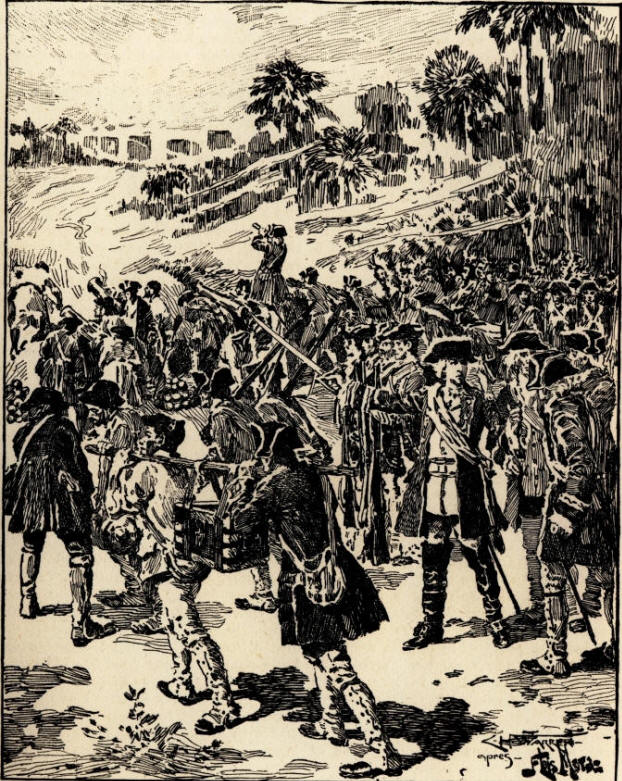St. Augustine
|
|
This Site:
|
St. Augustine, a city in Florida, founded by Menendez in 1565; population in 1900, 4,272. When Menendez gave up the chase of the Frenchmen under Ribault (see HUGUENOTS) he turned back towards the Florida coasts, entered an estuary in a boat manned by six oarsmen, leaving his large flagship at anchor outside, and, accompanied companied by his chaplain, Mendoza, and followed by other boats filled with "gentlemen" and ecclesiastics, he went ashore, while trumpets sounded, drums beat, cannons thundered, and flags waved. The chaplain walked at head of the procession, bearing a large cross and chanting a hymn. Pedro Menendez followed with his train, and carrying in his own hand the standard of Spain unfurled. Mendoza, arrayed in rich sacerdotal garments, kissed the cross, and then planted it in the sand by the side of the staff that upheld the royal standard, and against which leaned a shield bearing the arms of Spain. Then, after all had done homage to the priest, Menendez took formal possession of the country in the name of Philip of Spain. With such consecration he laid the foundation of the city of St. Augustine. From that spot he marched to the destruction of the Huguenots on the St. John, and there the unfortunate Ribault and his followers were slain (see RIBAULT, JEAN). Such was the human sacrifice at the founding of St. Augustine, now the oldest town in the United States. Soon after the beginning of "Queen Anne's War" (see ANNE, QUEEN) Governor Moore, of South Carolina, proposed an expedition against the Spaniards at St. Augustine. The Assembly appropriated $10,000 for the service. An army of 1,200 men (one-half Indians) was raised, and proceeded in two divisions to the attack. The governor, with the main division, went by sea to blockade the harbor, and the remainder, under Colonel Daniels, proceeded along the coast. The latter arrived first and plundered the town, the Spaniards retiring within their fortress with provisions for four months. Their position was impregnable, for the Carolinians had no artillery. Daniels went to Jamaica to procure battering cannon, but before his return two Spanish warvessels appeared. Governor Moore raised the blockade and fled. This expedition burdened the colony with a debt of more than $26,000, for the payment of which bills of credit were issued - the first emission of paper money in South Carolina. Oglethorpe, having been joined by a South Carolina regiment and a company of Highlanders, marched with his whole force, about 2,000 strong, to Fort Moosa, within 2 miles of St. Augustine, in May, 1740. The Spanish garrison evacuated the fort and fled into the town. Oglethorpe proceeded to reconnoitre the town and castle, and, finding they had more than 1,000 defenders, determined to turn the siege into a blockade with some ships lying at anchor near the bar. Having disposed troops so as to hold important points, Oglethorpe, with the remainder, went to the island of Anastasia, lying opposite, from which he might bombard the castle. After planting batteries there he summoned the Spanish governor to surrender ; but, secure in his stronghold, he sent word to Oglethorpe that he should be glad to shake hands with him in his castle. Indignant at this reply, the general opened his batteries against the castle, and, at the same time, threw a number of bombshells into the town. The fire was returned with spirit from the castle and armed ships, but the distance was so great that very little damage was done. Meanwhile a party of Spaniards went out and attacked the Georgian garrison at Fort Moosa and cut it in pieces. The Chickasaw Indians with Oglethorpe, offended at some incautious expression of his, deserted him, and the Spaniards by some means received a reinforcement of 700 men. All prospects of success began to fade. The Carolina troops, enfeebled by the heat of the climate and dispirited by much sickness, marched away in considerable numbers; and the naval commanders thought it imprudent to remain longer on the coast, for the season of hurricanes was nigh. The enterprise was accordingly abandoned in July.
Oglethorpe ExpeditionIn violation of the capitulation at Charleston, many of the patriotic citizens were torn from their families, taken to St. Augustine, and imprisoned, when they were required a second time to give their parole to keep within certain limits as the price of their release from close confinement. Among the prisoners was the sturdy patriot COLONEL CHRISTOPHER GADSDEN. He had been treacherously taken from his bed at night and conveyed on board a prisonship. Gadsden was required by the commanding officer at St. Augustine to give his parole. He refused, saying he had already given his parole and kept it inviolate, that his rights as a paroled prisoner had been violated, and that he would not trust his persecutors again. The commander haughtily said he would hear no arguments, and demanded an explicit answer whether Gadsden would or would not give his parole. " I will not," answered Gadsden, firmly. " In God I put my trust, and fear no consequences." He was confined in a loathsome prison, apart from his fellow-patriots, until exchanged, in July, 1781, eleven months after the surrender at Charleston. |
|
|
||
|
|
Site Copyright 2003-2018 Son of the South. For Questions or comments about this collection, contact: paul@sonofthesouth.net |
|
|
Are you Scared and Confused? Read My Snake Story, a story of hope and encouragement, to help you face your fears. |
||
